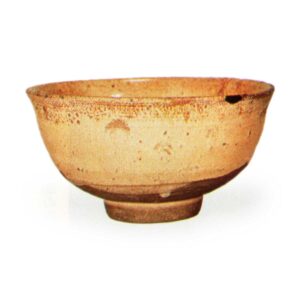
This is a piece from the Momoyama period (1573-1600), which antique dealers call “Ko-karatsu”. At this time, tea ceremonies were popular and people loved Koryo tea bowls, but there were few imported ones and they were difficult to obtain, so they had them copied in Karatsu. In later times, this was called Oku Koryo. Oku” is the same as “old Koryo,” which means “old days. The pottery has a rather dense texture and a loquat-like glaze color, and some pieces have a blueish-yellow glaze. The wrinkle patterns within the base are considered to be good. According to one theory, Okukoryo is a Manchu kiln, and when Manchuria (northeastern China) was part of the Korean Koryo Dynasty, pottery from the Fushun area was brought to Japan, and the Japanese named it Okukoryo. The Japanese called it Oku-Goryeo because it was located further back than Goryeo in terms of our country. It is the oldest pottery similar to Ko-karatsu, and is made of finer haniwa clay than Ko-karatsu, so it appears to be a hard clay. Later, tea masters in Japan claimed that it was a mistake to label Ko-Karatsu as Oku-Koryo, and that Oku means old, and Oku-Koryo refers to the old Koryo ware. (Chado Senje, Kanko Zusetsu)



